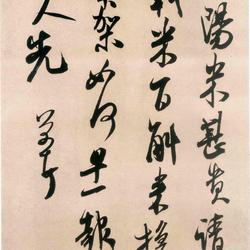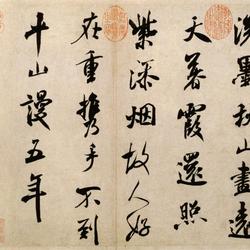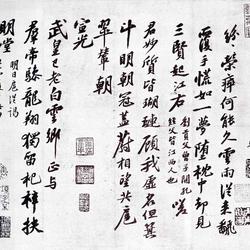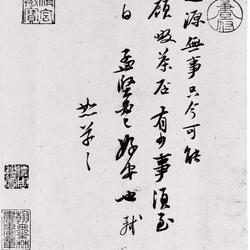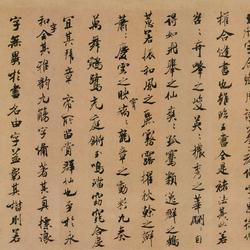Cuan Baozi's stele is called "The Tomb of Cuan Fujun, the Prefect of Jianning, General Zhenwei of the Jin Dynasty" in full. It was unearthed in Yangqitian, 70 miles south of Qujing County (today's Yuezhou Town, Qilin District) during the reign of Qianlong and Wuxu (1778 AD). In the second year of Xianfeng (1852), it was moved to Qujing City and now exists in the Cuan Stele Pavilion in the Cuan Garden of No. 1 Middle School in Qujing. The head of the monument is semi-elliptical, and the entire monument is rectangular, 1.83 meters high, 0.68 meters wide, and 0.21 meters thick. There are 5 lines of inscriptions on the forehead of the stele, with 3 characters in each line; 13 lines of inscriptions, with 7-30 characters in each line; and 13 lines of titles of officials at the bottom of the stele, with 4 characters in each line. The whole monument contains 400 words in total. Except for the last word in the last line of the title, which is incomplete, the rest are basically complete and clearly visible. On the lower left side of the stele is engraved a postscript by Deng Erheng, the prefect of Qujing in July of the second year of Xianfeng, recording the excavation and removal of the stele.
Yuan Jiagu, a native of Yunnan, once wrote a couplet for the stele pavilion: "Follow the tycoon of the Eastern Jin Dynasty, and the treasure will be enhanced by three hundred words. It is called Xiaocuan of Southern Yunnan, and the stele will live for two thousand years." The "three hundred" and "two thousand" here are for For language comparisons, take the divisor. In fact, it has been nearly 1,600 years since the monument was erected, and the inscription has a total of 388 words. Tycoon was the reign name changed by Emperor Jin'an in the Renyin year (402 AD). The following year it was renamed Yuanxing, and in Yiji (405 AD) it was renamed Yixi. Yunnan is far away on the border and does not know the changes in the era names in the mainland, so it still uses them.
The Cuan family has a long history as a popular surname and a wealthy family in Nanzhong. As early as the Three Kingdoms era, Zhuge Liang personally conquered Yunnan, and after quelling the rebellion of the Nanzhong surnames, he "recruited his heroes" as local officials, including "Jianning Cuanxi", who became an official and led the army; Zhuge Liang also "moved Nanzhong's elite soldiers" to enrich the army. The army of the Shu Han Dynasty was "divided into weak ones and divided into tribes with the surnames Jiao, Yong, Lou, Cuan, Meng, Liang, Mao and Li". By the Northern and Southern Dynasties, the Cuan family had dominated Nanzhong. In 1971, a stone inscription was unearthed in Luliang County, which read: "On the eighth day of the first lunar month of the fifth year of Tai (Tai) and the year of Tai (Xin), Wuyin established Cuan Longxiang's tomb." "Longxiang" is the name of a general in Jin Dynasty, whose status is slightly lower than that of Sangong. The rulers of the southern and northern dynasties of Jin Dynasty were often given the title "Longxiang". Although this stele contains only a few words, it proves that more than 80 years before the "Cuan Baozi Stele", someone from the Cuan family served as General Long Xiang. His family has long been famous and dominant.
The Southern Dynasties followed the Jin system and prohibited the erection of stele, so there were very few stele inscriptions. However, Yunnan's "Er Cuan" ("Cuan Baozi Stele", "Cuan Longyan Stele") can be said to be as bright as stars, shining in the night sky. Compared with the "Cuan Longyan Stele", this stele has fewer words and the stone stele is smaller (1.83 meters high and 0.86 meters wide), so later generations called the "Cuan Baozi Stele" "Xiao Cuan". The "Cuan Baozi Stele" was erected by leaders of ethnic minorities in the border areas of Yunnan who were influenced by Han culture and imitated the Han system. "Cuan Baozi Stele" has many different characters. Later generations have many explanations. The script is regular script with obvious official meaning. Some of the horizontal paintings on the stele still retain the wavy style of official script, but the structure is square and close to regular script. The brush used is mainly square, which is dignified and simple, and there is skill in clumsiness. It looks stupid, but it is always flying and full of ancient spirit. Li Genyuan said that the stele's "steel is as strong as iron, and its beauty is like that of a goddess"; Kang Youwei said that its calligraphy is "simple, thick, ancient and luxuriant, with all kinds of strange postures". Kang Youwei's "Guang Yi Zhou Shuang Ji" commented that this stele is "as simple as an ancient Buddha", which is very appropriate.
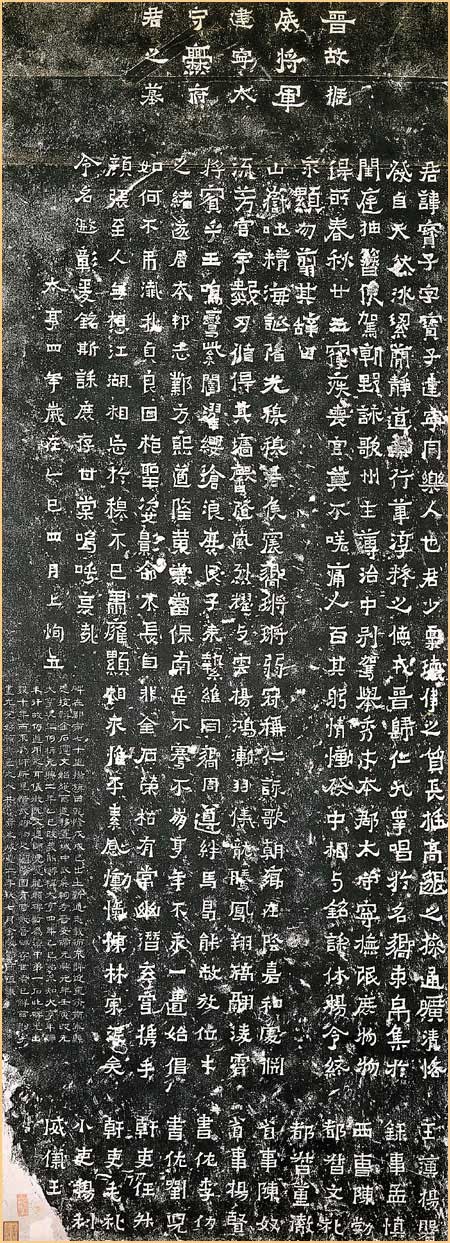
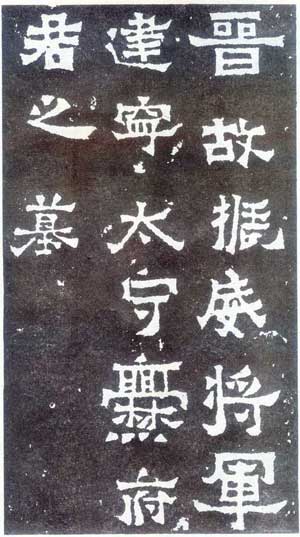
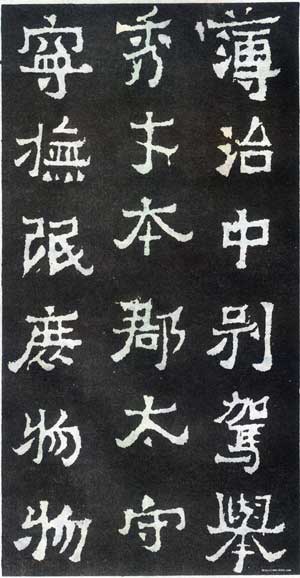
Interpretation: The tomb of Cuanfu Jun, the prefect of Jianning, General Zhenwei of the Jin Dynasty
Your name is Baozi, named Baozi, and he is a Jianning Tongle person. Mr. Jun is endowed with great qualities, tall and tall, open and clear, originating from nature, cold, simple and quiet, and the way is reed. With pure and pure virtue, he went to the Jin Dynasty and returned to Ren, Jiugao sang to the sound of fame, and bundled silks and gathered them in the boudoir. The hairpins are pulled out and the people sing songs in the court and the public. The governor of the state registers, governs the middle, does not drive, promotes talents, and is the prefect of the county. He would rather care for the common people and get everything he needs. On the twenty-third day of the Spring and Autumn Period, when an official is sick or bereft of an official, everyone laments and mourns. Hundreds of people bow to each other, in mourning, and pay tribute to each other. His words said:
The mountains vomit semen, the sea is full of light, the kings and nobles are vibrating, and the sound is clanging. Weak crowns are praised for benevolence, and songs are sung to pay homage to one's hometown. In Yinjiahe, the place is full of beauty. There are several palaces, and its walls can be traced. Xin follows the strong wind, and shines with the clouds. Hongjian's feathers are flying, the dragon is soaring and the phoenix is flying. He straightens his feathers and reaches the sky, bringing guests to the king. Ming Luan Zi Da, Zhuo Ying Cang Lang. When the common people come, their sincerity will resonate with them. Zhou Zun tripped his horse, and He was able to pardon and let him go. Because of his position and talent, he settled in his own country. Zhiye Fangxi, Daolong Huangshang. When protecting Nanyue, it will not collapse even if it is not strong. Life will never last forever, and it is the first time to advocate it. How can you not hang up and annihilate my Zhenliang? The saintly posture of returning the spear will not last long. Since it is not gold and stone, its prosperity and decline are constant. Hidden in the mysterious sky, hand in hand with Yan Zhang. When people have no thoughts, they forget each other. Yu Mu couldn't help but Su Yong showed his appearance. Yongwei is ordinary, grieving and generous. Lin Zong is dead, and his reputation is outstanding. Yuan Ming Si Wei, common people save Gantang. Alas!
The tycoon was established on April 4th at the age of four
Chief Recorder Yang Pan Recording Events Meng Shen Xicao Chen Bo Governor Wenli
Governor Dong Che saves trouble Chen Nu saves trouble Yang Xian Shu Zuo Li Ren
Shu Zuo Liu Er Official official Ren Sheng Official official Mao Li Xiaoli Yang Li
majestic king □

